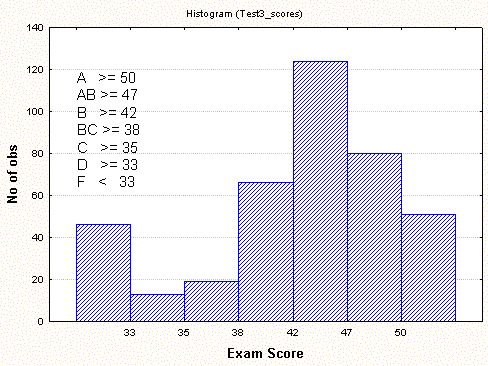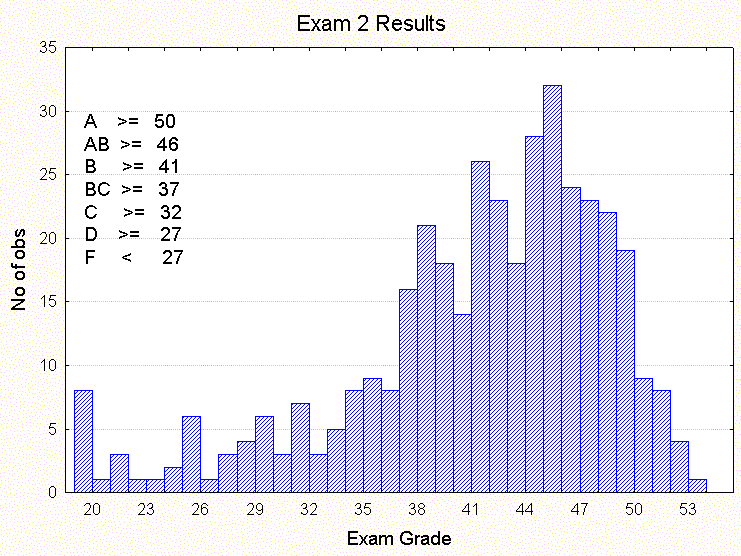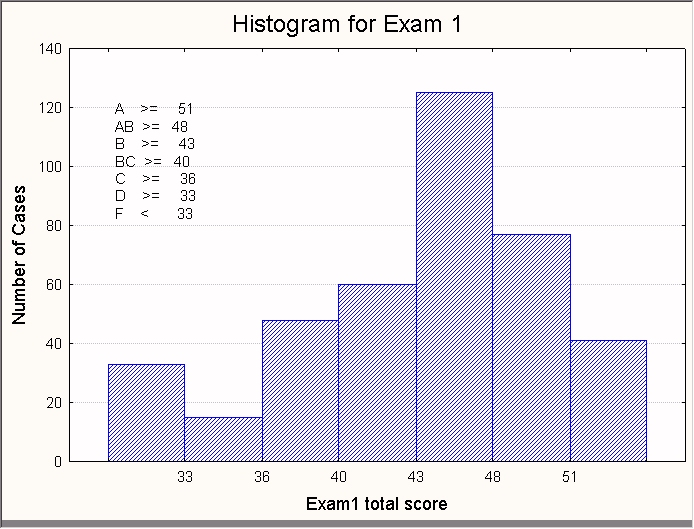

 |
AnnouncementsThanks folks for a great class. Below is a figure demonstrating the grade cutoffs for the third exam. The course grades are summarized under 'check your grade'. A COUPLE OF IMPORTANT NOTES:

The Review Session for the Final Exam will be held on Tuesday, December 10th from 5:30 - 7 PM in 165 Bascom. Bring questions! Last Chapter to read is Chapter 11, the whole thing. Key terms:Air-mass thunderstorm, Capping inversion, Cell, Cumulus stage, Dissipating stage, Entrainment, Flash flood, Flood, Funnel cloud, Gust front, Hail, Hailshaft, Hailswath, Hook echo, Lightning, Mature stage, Mesocyclone, Mesoscale convective complex (MCC), Multicell, Nocturnal low-level jet, Ordinary cell, Overshooting top, Severe thunderstorm, Shelf cloud, Squall line, Supercell, Thunderstorm, Tornado, Tornado alley, Tornado vortex signature (TVS), Wall cloud The snowfall forecasting contest has ended, we had winners which will be posted this week. Week of Dec 2: Chapter 10, the entire chapter. This chapter presents what in meteorology are called 'case studies' The first deals with the weather associated with the sinking of the Edmund Fitzgerald, the second with the plane crash of J. Kennedy Jr. The third and final exam will be on Dec 12 during regular class hours. Check my grade link is up and working, it includes 4 inclass assignments, both exams and 4 homeworks. The conversion from number grade to letter grade for the second exam is given in the figure below (the first exam is further down). Remember, the final grade is determined through an accumulation of points.
 Readings to dateWeek of Dec 2: Chapter 10, the entire chapter. This chapter presents what in meteorology are called 'case studies' The first deals with the weather associated with the sinking of the Edmund Fitzgerald, the second with the plane crash of J. Kennedy Jr. Week of Nov 25: Chapter 9 pages 249-268; Key terms: airmass, air mass modification, cold frpont, cP, cT, dryline, front, mP, mT, occluded front, overrunning, static stability, stationary front, warm front. Week of Nov 11: More on El Nino and La Nina and its impact on our weather. Exam on Thursday (make up exams are 5 short essays.) Week of Nov 4: Chapter 8 on El Nino and broad ocean patterns. Week of Oct 28: We will finish Chapter 6 and start Chapter 7. Read all of Chapter 7, the key terms in Chapter 7: Angular momentum, doldrums, Hadley cell, horse latitudes, index cycle, Intertropical Convergence Zone or ITCZ, jet stream, Midlatitude westerlies, Polar easterlies, Polar front, poleward transport of energy. Exam will most likely be Thursday Nov 14. Week of Oct 21: A new pretest has been posted and will stay up until Thursday. Thursday we will begin discussing material on Chapter 6, on atmospheric winds and the forces that make the air move. Check my grade link is up and working. The conversion from number grade to letter grade for this exam is given in the figure below:  Example essay exam answers from your fellow students. Frost occured at my home on the morning of October 6 - FROST contest is over, Scott Sable is the winner. Question of the week winners are also posted along with a new question. A short pretest is also up and running. Week of Oct 7 Reading: Chapter 5. With emphasis on the Intro, pages 133-146; and Atmospheric Optics. Key terms: Crepuscular rays, critical angle, diffraction, dispersion, Doppler radar, GEO satellite, halo, index of refraction, mirages, satellite images, rainbows, radar echo, radar reflectivity, reflection, refraction, scattering, sundogs, sun pillar, total internal reflection, visibility.
Welcome to class! Weather engulfs us. Its influence can be both dramatic and subtle. Weather tempers how we dress, how we live, the music we play, and the art we create. It can destroy our homes and threaten our lives. It affects our daily activities, leisure, holidays, transportation, commerce, agriculture, and nearly every aspect of our lives. Our fascination with the weather has led to 24-hour weather networks, feature-length motion pictures, and an explosion of detailed weather data over the Internet. Weather and its ever-changing nature has always drawn the attention of people and at times altered their lives. Mark Twain said "everyone talks about the weather, but nobody does anything about it". You may not be able to change the weather, but you can discover the processes that determine weather. Learning about meteorology can and should be both enjoyable and relevant to your everyday life. Knowledge gained from this class can help you better understand nightly television weather reports and interpret news articles on impending climate change, greenhouse warming, the depletion of the ozone layer, the causes and effects of El Niño, and severe weather. You will experience and be influenced by these events throughout your lifetime and this class will help you to grasp the fundamentals and gain an appreciation of the complexities involved with these issues. Reading AssignmentsWeek of Nov 25: Chapter 9 pages 249-268; Key terms: airmass, air mass modification, cold frpont, cP, cT, dryline, front, mP, mT, occluded front, overrunning, static stability, stationary front, warm front. Week of Nov 18: Chapter 5 the Radar section: pages 144-146; Key terms: dopller effect, doppler radar, radar echo, radar reflectivity. Chapter 8 the Hurricane section: Pages 223-245; Key terms: eye, eye wall, hurricane, rainbands, storm surge, tropical cyclones, tropical depression, tropical disturbance, tropical storm, typhoon. Test 2 Week of Nov 11: More on El Nino and La Nina and its impact on our weather. Exam on Thursday (make up exams are 5 short essays.) Week of Nov 4: Chapter 8 on El Nino and broad ocean patterns. Week of Oct 28: Finish Chapter 6, start Chapter 7. Key terms in Chapter 7: Angular momentum, doldrums, Hadley cell, horse latitudes, index cycle, Intertropical Convergence Zone or ITCZ, jet stream, Midlatitude westerlies, Polar easterlies, Polar front, poleward transport of energy. Week of Oct 21: Thursday we will begin discussing material on Chapter 6, on atmospheric winds and the forces that make the air move. Key terms: Coriolis force, cyclones, force, frictional force, geostrophic balance, geostropic wind, gradient balance, gradient wind, inertia, isobaric charts, land/sea breeze, mesoscale, microscale, planetary scale, pressure gradient, pressure gradient force, synoptic scale, upper air charts, wind gust, and leeward & windward. Week of Oct 7 Reading: Chapter 5. With emphasis on the Intro, pages 133-146; and Atmospheric Optics. Key terms: Crepuscular rays, critical angle, diffraction, dispersion, Doppler radar, GEO satellite, halo, index of refraction, mirages, satellite images, rainbows, radar echo, radar reflectivity, reflection, refraction, scattering, sundogs, sun pillar, total internal reflection, visibility. Test 1 Sept 24, 26: Chapter 4. Key terms: ALL cloud types, dew point, relative humidity, vapor pressure, saturation vapor pressure, nuclei, dew, frost, rain, snow, freezing rain, sleet, all fog types, crystal shapes, lifting mechanisms, updraft. Sept 17 and 19, read chapter 3. Key terms to focus on include: temperature cycle, temperature range, anomalies, lapse rate, inversions, stable atmosphere, surface temperature, unstable atmosphere, wind-chill. Think of temperature changes in terms of how these changes relate to energy gains versus energy losses. For Sept 10 and 12 - Chapter 2 For Sept 5 and 6 - Chapter 1 Be familiar with the key terms at the end of the chapter. We are concerned with how energy is transferred and the balance between energy gains versus energy losses. Be familiar with the key terms, in particular: climate, condensation, density, evaporation, front, hydrologic cycle, isobar, isotherm, meteorology, micron, millibar, pressure, station model, stratopause, stratosphere, time zones, trace gas, transpiration, tropopause, troposhere, warning, watch, water vapor, weather. Know the symbols for fronts and how to decode the surface model. Here is a link to help you with learning how to decode the surface model: Here's some information if you are interested in majoring in meteorology. |